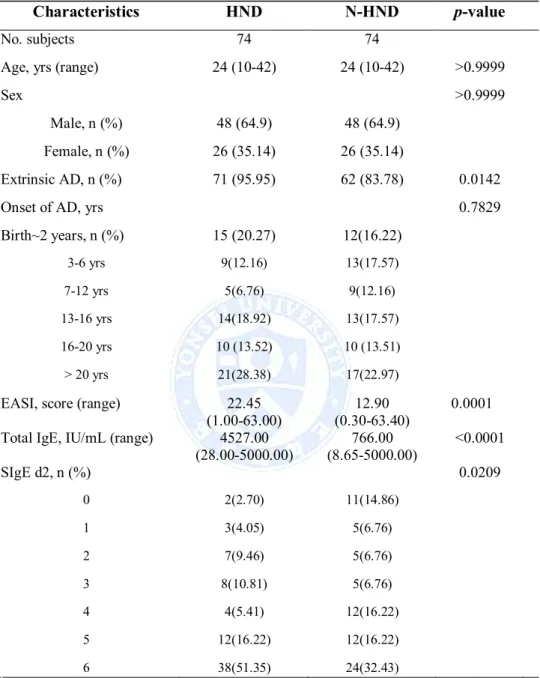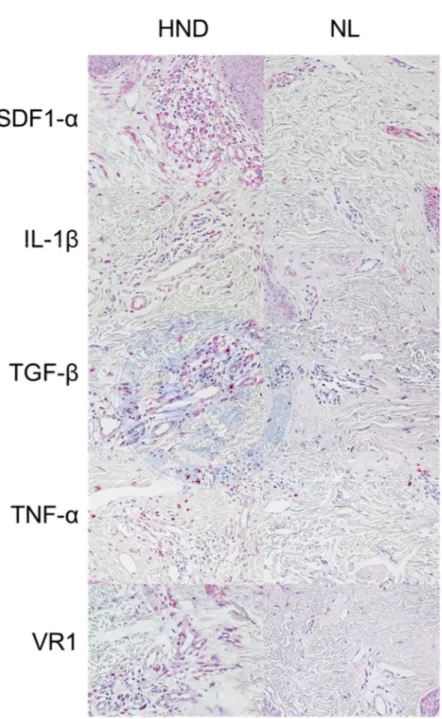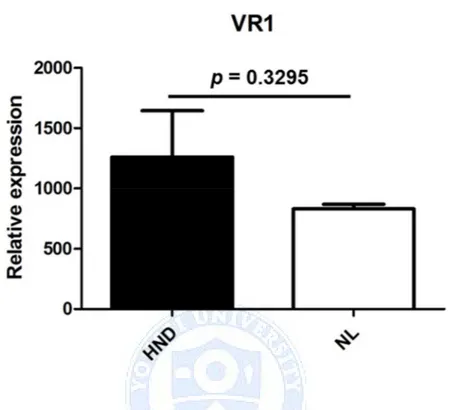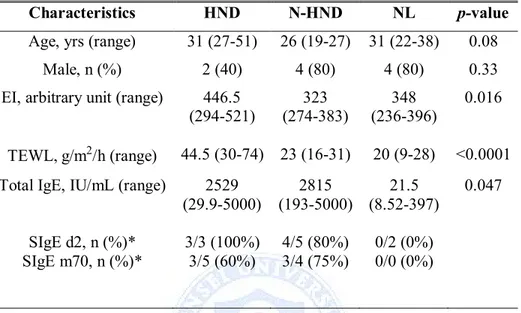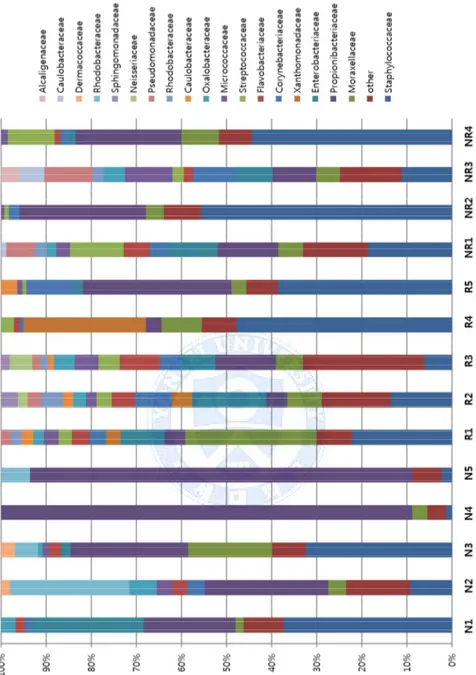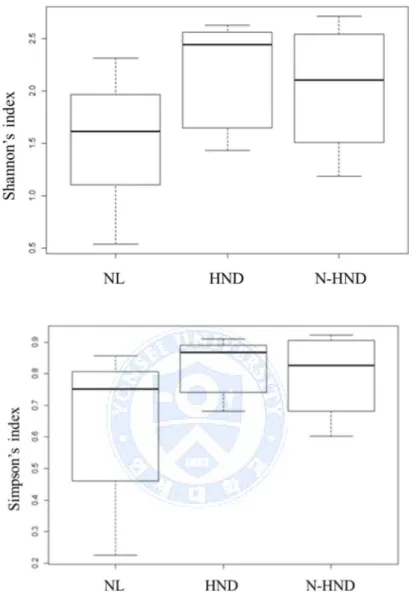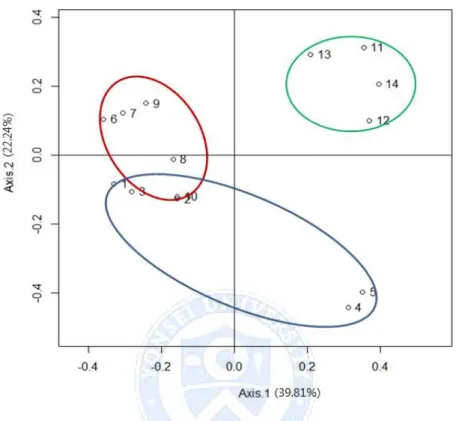저작자표시-비영리-변경금지 2.0 대한민국 이용자는 아래의 조건을 따르는 경우에 한하여 자유롭게 l 이 저작물을 복제, 배포, 전송, 전시, 공연 및 방송할 수 있습니다. 다음과 같은 조건을 따라야 합니다: l 귀하는, 이 저작물의 재이용이나 배포의 경우, 이 저작물에 적용된 이용허락조건 을 명확하게 나타내어야 합니다. l 저작권자로부터 별도의 허가를 받으면 이러한 조건들은 적용되지 않습니다. 저작권법에 따른 이용자의 권리는 위의 내용에 의하여 영향을 받지 않습니다. 이것은 이용허락규약(Legal Code)을 이해하기 쉽게 요약한 것입니다. Disclaimer 저작자표시. 귀하는 원저작자를 표시하여야 합니다. 비영리. 귀하는 이 저작물을 영리 목적으로 이용할 수 없습니다. 변경금지. 귀하는 이 저작물을 개작, 변형 또는 가공할 수 없습니다.
Exploratory Study of Clinical, Histological, and
Skin Microbiome Characteristics of Head and Neck
Dermatitis in Adult Atopic Dermatitis
Hemin Lee
Department of Medicine
Exploratory Study of Clinical, Histological, and
Skin Microbiome Characteristics of Head and Neck
Dermatitis in Adult Atopic Dermatitis
Directed by Professor Kwang Hoon Lee
The Master’s Thesis
submitted to the Department of Medicine,
the Graduate School of Yonsei University
in partial fulfillment of the requirements for the degree of Master of
Medical Science
Hemin Lee
This certifies that the Master's Thesis of
Hemin Lee is approved
Kwang Hoon Lee
---Thesis Supervisor : Professor Kwang Hoon Lee
Sang Sun Yoon
---Thesis Committee Chair : Professor Sang Sun Yoon
Ju Hee Lee
---Thesis Committee Member : Professor Ju Hee Lee
The Graduate School
Yonsei University
ACKNOWLEDGEMENTS
The final outcome of this study required much guidance and
inspiration from Professor Kwang Hoon Lee. I would like to gratefully
acknowledge him for all his support and encouragement along the
completion of this study.
I also owe my profound gratitude to Professor Ju Hee Lee and
Professor Sang Sun Yoon who took keen interest on this study and
offered invaluable professional advices and guidance.
I thank my colleagues in the lab and clinic, and also the patients who
consented to the utilization of their samples for this study. Last but not
least, I thank my family for their unchanging presence in my life.
TABLE OF CONTENTS
ABSTRACT ···1
I. INTRODUCTION ···3
II. MATERIALS AND METHODS ···6
1. Patients···6
2. Laboratory examinations ···7
3. Skin barrier determination···8
4. Immunohistochemistry and image analysis ···8
5. Skin microbiome analysis ···9
6. Statistical analysis ···10
III. RESULTS ···11
IV. DISCUSSION···30
V. CONCLUSION ···35
VI. REFERENCES ···36
LIST OF FIGURES
Figure 1. Evaluation of (A) HND and NL pathology and (B)
measurement of epidermal thickness ··· 14
Figure 2. Evaluation of vascular characteristics in HND and NL
pathology with (A) factor VIIIa-related antigen
immunohistochemistry and (B) measurement of vessel
count and average vessel area ··· 16
Figure 3. Results of immunohistochemical staining of HND and
NL pathology with SDF-1α, IL-1 β, TGF- β, TNF-α, and
VR1 at (A) original magnification x 200, (B) x400 ··· 19
Figure 4. Comparison of HND and NL pathology’s average
staining intensity for immunohistochemistry in (A) SDF-1α, (B)
IL-1 β, (C) TGF- β, (D) TNF-α, and (E) VR1··· 21
Figure 5. Skin microbiome in HND, N-HND, and NL skin ···· 27
Figure 6. Alpha diversity in skin microbiome analysis ··· 28
Figure 7. Beta diversity in skin microbiome analysis ··· 29
LIST OF TABLES
Table 1. Comparison of clinical characteristics between HND
and N-HND AD ··· 12
Table 2. Comparison of EI, TEWL, Total IgE, and SIgE in
1
<Abstract>
Exploratory Study of Clinical, Histological, and Skin
Microbiome Characteristics of Head and Neck Dermatitis
in Adult Atopic Dermatitis
Hemin Lee
Department of Medicine
The Graduate School, Yonsei University
(Directed by Professor Kwang Hoon Lee)
Head and neck dermatitis (HND) is a unique subtype of atopic dermatitis (AD) which commonly manifests in late adolescence or adulthood. HND’s presentation of chronic eczematous lesions with diffuse erythema and itching or pruritus is often refractory to therapy and affects patient’s quality of life. However, HND is often underappreciated in clinics and detailed studies characterizing this specific AD subtype is very limited.
This study sought to analyze the clinical and histological characteristics of HND patients. Further, as there are a growing number of AD studies focusing on the role of skin microbiome in the disease pathogenesis, microbiome analysis of HND patients in comparison to non-HND (N-HND) AD and normal (NL)
2 subjects was performed.
The results showed HND patients comprising approximately 2.4% of AD patients in an outpatient clinic setting. Compared to N-HND patients, HND initially presented with more severe disease status and elevated serum total IgE and serum specific IgE reactivity to Dermatophagoides farinae. Histologically, HND specimen showed thickened epidermis with increased vascular components and dermal inflammatory infiltrates. Although staining intensity did not differ between HND and NL specimen, the absolute number of staining intensity measurement was all higher in HND, supporting a contributory role of pro-inflammatory cytokines, chemokines, and neuroinflammatory factors in the HND pathogenesis. Lastly, the microbiome analysis of HND in comparison to N-HND AD and NL subjects showed no significant difference in the diversity of bacterial community.
Combining findings from this study reaffirm that HND is a clinical subtype of AD that needs distinction from classical AD. In the future, further investigation of skin microbiome and inflammatory factors involved in vasculatures of AD facial regions will lead to development of potential therapeutic targets.
Key words: head and neck dermatitis, red face syndrome, skin microbiome, atopic dermatitis
3
Exploratory Study of Clinical, Histological, and Skin
Microbiome Characteristics of Head and Neck Dermatitis
in Adult Atopic Dermatitis
Hemin Lee
Department of Medicine
The Graduate School, Yonsei University
(Directed by Professor Kwang Hoon Lee)
I. INTRODUCTION
Atopic dermatitis (AD) is a chronic, inflammatory skin disease affecting 1-3% of adults world-wide.1 Whereas classic AD seen during childhood mostly
involves flexural areas of extremities, AD in elderly often show unique clinical features of head and neck dermatitis (HND), hand eczema, or nummular eczema regardless of presence of typical AD lesions.2HND, which is also often referred
to as “red face syndrome,” arises after adolescent years and encompasses a variety of clinical features involving scalp, face, and neck with eczematous, scaly patches to rosacea-like diffuse erythema.3-5 From experience, HND
patients are generally refractory to therapy, and their quality of life is greatly affected by the presence of dermatosis.
4
However, a detailed clinical characteristics, frequency, or pathogenesis underlying HND in AD is still not clear. Many studies emphasize patients’ hypersensitivity to Malassezia furfur, dust mite, and various environmental factors such as sweating, heat, and dryness.4 Moreover, a long-term use of
topical steroid, or contact allergy to topical steroid is also suggested as a culprit in causing recalcitrant facial erythema.6
These erythematous changes are clearly evident in histological reviews as well, showing resemblance to rosacea and chronic eczema.7 Increased vasculature
noted in HND is a possible contributory factor in provoking inflammation in these patients, leading to a vicious cycle.
In more recent works, following advances in DNA sequencing, the focus of AD pathogenesis has shifted to analyzing microbial community.8 Even before the
utilization of 16S rRNA for microbiome analysis, bacterial colonization by
Staphylococcus aureus has long received attention in AD, with density of S. aureus colonization showing correlation to AD severity.9 It was hypothesized
that the disrupted skin barrier often present in AD patients increases the number of skin colonization by microbes and eventually lead to subsequent IgE sensitization.10
Notable skin microbiome analysis in AD has been reported by Kong et al.,11
characterizing a reduction in overall microbial diversity in flares of childhood AD but a corresponding increase in Staphylococcus spp. But despite a number of microbiome studies in AD involving forearm or flexural areas, microbial
5
community of other areas involved in AD has not yet been investigated.
Commonly attempted treatment modalities for HND target the vessel
components,12,13 or include anti-fungal medication to eradicate possible
colonization with Malassezia.14 A trial of oral antibiotics minocycline,
tetracycline have also been tried under a rationale to treat the disease similar to rosacea group. While these treatments show some improvement, none have been definitive, probably due to the heterogeneous nature of HND’s etiology. Therefore, gathering a need for a comprehensive study on HND to thoroughly understand its pathogenesis, the objective of this study was to describe HND’s clinical, histological, and microbial characteristics in comparison to control subjects.
6
II. MATERIALS AND METHODS
1. Patients
A. Patients for clinical analysis
For clinical evaluation of HND patients, a database of approximately 5007 AD patients who visited Yonsei University Severance Hospital’s Department of Dermatology was utilized. A query search of patients’ electronic medical records with keywords “redface syndrome” “red” “redface” – a synonym often used in clinic for HND—in both English and Korean were searched.
B. Patients for histological analysis
For histological evaluation of HND, histological database at Yonsei University Severance Hospital was utilized. A query search of AD patients who performed skin biopsy from face since year 2011 was performed, and 3 patients were randomly selected from candidates of 9 patients. Histological analysis of NL face specimen was selected through a query search of patients who underwent skin biopsy since year 2013 on the face for suspected vitiligo or morphea. A crude age filtering of patients was performed to match AD patients’ age. Non-lesional specimens of these patients were chosen as NL face pathology. Among 10 candidates, 3
7
patients were randomly selected for image analysis.
C. Patients for microbiome analysis
For microbiome analysis of HND, 5 adult patients with AD based on Hanifin and Rajka criteria with striking redness on face were enrolled. Another 5 adult AD patients with typical AD lesions on flexural areas but no apparent HND were also enrolled as N-HND group. Finally, 5 NL subjects without AD were recruited. Considering a small sample number, the groups were enrolled age and sex matched.
Peripheral blood samples and skin swab culture were obtained from enrolled patients as well as measurement of transepidermal water loss (TEWL) and objective measurement of redness with erythema index (EI). The major inclusion enrollment criterion was based on the following: no local or systemic treatment for at least 2 weeks prior to blood sampling, no significant infection or immune suppression, and no significant renal, hepatic, or other medical diseases.
2. Laboratory examinations
A. Laboratory evaluation for clinical analysis
In a database of approximately 5007 patients available at Yonsei University Severance Hospital’s Department of Dermatology, laboratory evaluation from peripheral blood samples for total IgE and serum specific IgE (SIgE)
8
to D. farinae were available during their initial visit.
B. Laboratory evaluation for microbiome analysis patients
In 15 patients who underwent skin swab for microbiome analysis, SIgE to
D. farinae and Malassezia spp. were measured along with serum total IgE.
3. Skin barrier determination
In 15 patients who underwent skin swab for microbiome analysis, skin barrier function was determined by measurement of TEWL with tewameter (Courage+Khazaka, Köln, Germany). Objective measurement of redness with EI was performed with Mexameter® (Courage+Khazaka). All values were measured three times per study subject.
4. Immunohistochemistry and image analysis
Immunohistochemical stains were performed using paraffin-embedded sections using antibodies against SDF1-α (1:100, ab25117, Abcam, Cambridge, United Kingdom), IL-1-β (1:100, ab2105, Abcam), TNF-α (1:50, ab1793, Abcam), TGF-β (1:100, ab66043, Abcam), and VR1(1:500, ab74855, Abcam).
At 100x magnification, the longest distance from sub-corneal level to basal layer was chosen arbitrarily for epidermal thickness after calibrating the scale bar to pixels. Number of vessels/mm2 was counted in the dermis of each slide
9
intensity was determined at 400x magnification at a randomly chosen area in the upper dermis with staining uptake under a constant staining intensity scale. The images were analyzed using MetaMorph Software (Molecular Devices, Downingtown, PA, USA).
5. Skin microbiome analysis
A. Sampling and specimen processing
Specimens from skin were obtained from erythematous lesions of cheek and forehead in HND patients. In N-HND AD patients, specimens were collected from acute eczematous lesions of face distinct from chronic lesions seen in HND patients. In normal patients, specimen was collected from cheeks and forehead. Sampling was performed with skin swab of amies transport medium without charcoal. DNA was extracted from preparations using the DNeasy blood and tissue kit (Qiagen, Chatsworth, CA, USA) following the manufacturer’s protocol for genomic DNA isolation of Gram-positive bacteria.
B. 16S rRNA PCR amplification and sequencing
Two different primer sets were used for PCR, V2-4-8 and V3-6, 7-9 from
the Ion 16STMMetagenomics Kit (Life Technologies, Carlsbad, CA, USA).
Amplification products were purified and libraries were prepared using Ion Plus Fragment Library Kit (Life Technologies) and Ion Xpress™ Barcode
10
Adapters 1-16 Kit(Life Technologies) followed by template preparation using the Ion PGM Template OT2 400 Kit and the Ion OneTouch 2 System (Life Technologies). Sequencing was performed on an Ion Personal Genome Machine (PGM) System (Life Technologies), using the Ion PGM Sequencing 400 Kit with Ion 318 Chip v2. Bacterial identification was reported by the Ion Reporter (Life Technologies) using 2 databases, MicroSEQ(R) 16S Reference Library v2013.1 and Greengenes v13.5.
6. Statistical analysis
The Student’s t-test for dependent samples or the nonparametric test of Wilcoxon was used for comparison of quantitative values between two groups. When comparing more than two groups, Kruskal-Wallis test was used. The condition of variables for normality was evaluated by Shapiro-Wilks test. The diversity of the microbial community was expressed as Simpson’s reciprocal index of diversity (1/D) and Shannon’s index. Differences in diversity data were analyzed using ANOVA with Tukey’s HSD post hoc test. Beta diversity was analyzed with principal coordinates analysis (PCoA) using the Yue-Clayton theta (θ) similarity coefficient. Quantitative data were described as median and range or as mean ± standard deviation. Statistical differences were considered to be significant if p < 0.05 using SAS (version 9.2, SAS Inc., Cary, NC, USA), and R package, version 3.1.2 1.2 (R Foundation for Statistical Computing, Vienna, Austria).
11
III. RESULTS
1. Clinical characteristics of HND patients visiting outpatient clinic
In overall, there were 5007 AD patients who were enlisted in Yonsei University Severance Hospital’s Department of Dermatology AD database since year 2007. Among the 5007 patients, there were 120 patients (2.4%) with clinical records indicating a presence of HND. 120 HND and 4887 N-HND patients were age and sex matched with exact matching method. After eliminating all missing values in the database, a total of 74 HND and 74 N-HND patients were matched for comparison. There was no significant difference in the distribution of age and sex between HND and N-HND patients (age, p>0.9999, sex, p>0.9999). There was more percentage of extrinsic AD (total serum IgE higher than 200 IU/mL or positive SIgE to D. farinae) patients in the HND group (p=0.0142). Also, HND patients presented with higher disease severity (p=0.0001), elevated total IgE (p<0.0001) at their initial clinic visit, and HND patients showed higher proportion of positive SIgE to D. farinae (p=0.0209). The onset age of AD in both groups was not different (p=0.7829). The comparison of HND with N-HND patients is shown in Table 1.
12
Table 1. Comparison between HND and N-HND
Characteristics HND N-HND p-value
No. subjects 74 74
Age, yrs (range) 24 (10-42) 24 (10-42) >0.9999
Sex >0.9999
Male, n (%) 48 (64.9) 48 (64.9)
Female, n (%) 26 (35.14) 26 (35.14)
Extrinsic AD, n (%) 71 (95.95) 62 (83.78) 0.0142
Onset of AD, yrs 0.7829
Birth~2 years, n (%) 15 (20.27) 12(16.22) 3-6 yrs 9(12.16) 13(17.57) 7-12 yrs 5(6.76) 9(12.16) 13-16 yrs 14(18.92) 13(17.57) 16-20 yrs 10 (13.52) 10 (13.51) > 20 yrs 21(28.38) 17(22.97)
EASI, score (range) 22.45
(1.00-63.00) (0.30-63.40)12.90 0.0001 Total IgE, IU/mL (range) 4527.00
(28.00-5000.00) (8.65-5000.00)766.00 <0.0001 SIgE d2, n (%) 0.0209 0 2(2.70) 11(14.86) 1 3(4.05) 5(6.76) 2 7(9.46) 5(6.76) 3 8(10.81) 5(6.76) 4 4(5.41) 12(16.22) 5 12(16.22) 12(16.22) 6 38(51.35) 24(32.43) 5
Abbreviations: HND: head and neck dermatitis; N-HND: non-head and neck dermatitis, AD: atopic dermatitis; EASI, Eczema Area and Severity Index; SIgE: serum specific IgE, d2, D. farinae
13
2. Histology of HND shows prominent epidermal change with
presence of dense inflammatory cells and increased vasculature.
To first investigate the general architecture of histological differences in HND to NL face histology, skin biopsy specimen were examined under hematoxylin and eosin (H&E) staining. In HND pathology, a general trend of hyperkeratosis, acanthosis, and parakeratosis was observed with dense inflammatory cells surrounding increased vasculatures (Figure 1A). When epidermal thickness was
measured, the average epidermal thickness in HND group (0.5633 ± 0.04 mm)
was significantly increased compared to NL group (0.17±0.06 mm). (p=0.0001,
Figure 1B).
Increased vascularity in HND patients was additionally confirmed by immunohistochemical staining of factor VIII-related antigen (Figure 2A). Average vessel count for HND group was 15 ± 1.14 with concurrent average vessel area of 217.4 ± 20.63 µm2. On the other hand, average vessel count in
normal face pathology was 4.50 ± 0.65 with average vessel area of 114.6 ± 21.60 µm2. The difference in vessel count and average vessel size was
14
A)
15
Figure 1. (A) Histological evaluation of face biopsy specimen in HND (left) show hyperkeratosis, acanthosis, and parakeratosis. Epidermal change is less prominent in NL face pathology (right). Also, dermis of HND shows prominent inflammatory cell infiltration with increased vessel components. (B) Average epidermal thickness of HND (0.5633 ±0.04 mm) was increased compared to average epidermal thickness of NL control (0.17±0.06 mm). (p=0.0001).
16
A)
17
Figure 2. (A) Immunohistochemistry for factor VIIIa-related antigen revealed increase in the number and size of vessels in the upper dermis of HND (left) compared to NL (right). Red arrows indicate endothelial cells of vessels in the dermis. Original magnification 100 x. (B) Average vessel count (15 ± 1.14) and average vessel area (217.4 ± 20.63 µm2) for HND was
significantly increased compared to average vessel count (4.50 ± 0.65) and average vessel area (114.6 ± 21.60 µm2) of NL pathology (Vessel count,
18
3. Immunohistochemical staining reveals increased uptake in HND,
but the average staining intensity detected in HND and NL show
comparable results.
Pathology of HND and NL face pathology were further compared with immunohistochemical staining for SDF1-α, IL-1β, TGF-β, TNF-α, and VR1. An absolute increased uptake in epidermis and dermis of HND was observed (Figure 3A, B). However, in image analysis of expression of relative staining intensity in the dermis showed no statistically significant difference between the two groups (Figure 4 A-E).
19
20
B)
Figure 3. Results of immunohistochemical stain at (A) original magnification x 200 and (B) original magnification x 400.
21
A)
22
C)
23
E)
Figure 4. Comparison of HND and NL pathology’s average intensity for immunochemistry staining in (A) SDF-1α, (B) IL-1 β, (C) TGF- β, (D) TNF-α and (E) VR1. Although absolute values of staining intensity were all higher in HND, the only statistically significant difference was seen in (B) IL-1 β staining (p=0.008).
24
4. Baseline characteristics of patients undergoing skin swab for
microbiome analysis
Patients participating in skin microbiome analysis (5 HND, 5 N-HND AD, 5 NL) all performed measurement of TEWL to assess skin barrier function and EI to objectively record the degree of erythema. Moreover, baseline laboratory workups of serum total IgE, and SIgE to D. farinae and Malassezia spp. were performed.
EI in HND, N-HND, and NL groups was 446.5 (294-521), 323 (274-383), and 348 (236-396), respectively. A significant difference was noted in EI between the three groups (p=0.016), with markedly higher EI in the HND than in the N-HND or NL group (p=0.008, p=0.021). There was no difference between EI of N-HND and NL group (p=0.440).
TEWL between the three groups differed significantly as well (p<0.0001). There was no statistically significant difference between TEWL of N-HND and NL group (p=0.018), but TEWL in HND and N-HND group, HND and NL grouped proved to be significant (p<0.0001, p<0.0001, respectively). Difference in serum total IgE in three groups was noted (p<0.047), but comparison of each group in Mann-Whitney using Bonferroni correction showed no significant result. Summary of baseline characteristics are shown in Table 2.
25
Table 2. Comparison of EI, TEWL, Total IgE, and SIgE in patients
undergoing microbiome analysis
Characteristics HND N-HND NL p-value
Age, yrs (range) 31 (27-51) 26 (19-27) 31 (22-38) 0.08
Male, n (%) 2 (40) 4 (80) 4 (80) 0.33
EI, arbitrary unit (range) 446.5
(294-521) 323 (274-383) 348 (236-396) 0.016 TEWL, g/m2/h (range) 44.5 (30-74) 23 (16-31) 20 (9-28) <0.0001
Total IgE, IU/mL (range) 2529
(29.9-5000) 2815 (193-5000) 21.5 (8.52-397) 0.047 SIgE d2, n (%)* 3/3 (100%) 4/5 (80%) 0/2 (0%) SIgE m70, n (%)* 3/5 (60%) 3/4 (75%) 0/0 (0%)
Abbreviations : EI, erythema index; TEWL, transepidermal water loss; HND, head and neck dermatitis, N-HND, non-head and neck dermatitis, NL, normal, SIgE, serum specific IgE; d2, D. farinae; m70, Malassezia spp.
*SIgE result is shown in proportions of patients who showed reactivity and its
26
5. Species richness and diversity within skin microbiome samples of
face
Skin microbiome analysis was performed in 5 HND, 5 N-HND, and 5 NL patients. One sample of N-HND patient was discarded due to insufficient quantity of bacterial sample obtained in PCR quantification.
After 16s rRNA gene deep sequencing, bacterial phyla consisting less than 1% of total reads mapped were excluded. The most commonly detected phyla were
Firmicutes, Actinobacteria, Proteobacteria, and Bacteriodetes. A more detailed
analysis was carried out at a family level, and a total of 16 families were detected. The mapped families and their proportions are shown in Figure 5. Based on 16s rRNA gene deep sequencing data, alpha diversity was assessed by Simpson’s diversity index (1/D) and Shannon’s diversity index. There was no statistically significant difference between the HNL, N-HND, and NL group’s alpha diversity of the total microbiota (Simpson’s p=0.37, Shannon’s p=0.30, Figure 6).
Beta diversity analysis, which calculates the similarity between individuals, was performed with unweighted unifrac principal coordinates analysis (PCoA) and showed that each group shares similar microbiome communities (Figure 7). Lastly, when proportion of Staphylococcaceae family was compared, (HND: 22.56%, N-HND: 27.69%, NL: 25.07%) the difference between the three groups was significant (p<0.001).
27
Figure 5. Comparison of skin microbiome in HND, N-HND, and NL
patients. Diverse composition of microbiota is present at a family level.
Abbreviations: N, Normal; R, head and neck dermatitis; NR, non-head and
28
Figure 6. Simpson’s and Shannon’s alpha diversity index of the microbiota.
Error bars represent 95% confidence interval of the mean. No statistically
significant difference was seen between the groups.
Abbreviations: NL: normal, HND: head and neck dermatitis, N-HND:
29
Figure 7. Unweighted unifract principal coordinate analysis (PCoA) plot of
beta diversity. Plots 1~5 indicate normal (NL) group, plots 6~10 indicate
head and neck dermatitis (HND), and plots 11~14 indicate non-head and
neck dermatitis (N-HND). Percentage variation attributed to an axis is
30
IV. DISCUSSION
Even though a world-wide prevalence of AD has increased over the years, epidemiology and characteristics of AD in adult population have rarely been examined.15The classic course of AD is onset of eczema in infancy to childhood
years and subsiding of the disease before adolescence.16 However, adult-onset
AD is not a rare presentation with reported prevalence around a range of 1-3%.17Among many patterns of clinical phenotypes present in adult AD patients,
the most common presentation is recurrence of pre-existing eczema.3,18 But
other distinct phenotypes of HND, nummular eczema, and hand eczema are also observed.5
HND is AD subtype that can be seen in patients without evident eczema history
in childhood.19However, this study’s analysis of onset age of AD in HND and
N-HND revealed no apparent difference in the period of initial diagnosis of AD. Although there is a possible recall bias in this data considering a retrospective and survey nature of the data collection, more proportions of extrinsic AD patients and a higher number of patients with positive SIgE to D. farinae in HND group lead to an assumption that environmental and other extrinsic factors are more influential in the development of HND than genetic or inherent traits. In addition, higher disease severity score present in HND could manifest that
31
HND patients have eczema affecting other body sites as well or suffer from more refractory disease.
A past study which overlooked histological features of adult AD patients with recalcitrant erythema on the face demonstrated a mixture of eczematous and steroid-induced rosacea-like changes.7 Not too different from an already
published work, histological observation in this study showed epidermal change of hyperkeratosis, acanthosis, with parakeratosis, and a presence of increased vessels in HND lesions. Increase in the number and average area of vessels in the dermis, confirmed with factor VIII-related antigen, most probably lie behind the intense redness noted in HND patients.
Immunohistochemical staining with proinflammatory cytokines and chemokines was additionally performed to confirm the presence of inflammatory mediators in AD lesions. As this study’s focus was on the redness of HND, the initial mark was set on vessel-related components. One major vascular component, VEGF, was already reported to be 25 times higher in AD lesional scale production compared to production in normal stratum corneum.20
But because VEGF can be up-regulated by other cytokines, this study aimed to check on the presence of other pro-inflammatory cytokines including TNF-α, TGF-β, and IL-1β, and chemokine SDF1-α. For one, TNF-α causes NF-κB activation as a transcription factor and regulate cell adhesion molecules (CAM),
32
while IL-1 family contributes to dermal microvascular endothelial cells by up-regulating intracellular adhesion molecule 1 (ICAM-1) or E-selectin expression.21 Chemokines also work in a cross-talk between endothelial cells
and leukocytes involved in AD.21,22Yet although the absolute values of staining
intensity were all higher in immunohistochemistry work-up for HND group, there was no statistically significant difference in the two groups except IL-1β. Nevertheless, a plethora of pro-inflammatory mediators present in HND lesions might all act synergistically to contribute the expression of VEGF or other factors that ultimately lead to vessel dilatation and hyperpermeability, and future studies confirming their functional relevance will be necessary.
One of notable immunohistochemical staining done in this study was staining of TRPV1 receptor, RV1. TRPV1 is a cation channel highly expressed in epidermal keratinocytes and nerve fibers of epidermis and dermis that is activated after stimulation with capsaicin, low pH or heat.23Its role in rosacea,
phenotypically similar in showing flush-like redness in face, has been gaining importance as TRPV1 opens a nonselective cation channel upon activation to increase intracellular calcium and mediate the release of neuropeptides like substance P and calcitonin gene-related peptide (CGRP). Since substance P possesses ability to mediate vasodilation and vascular permeability, it may parallel a release of mast cell and histamine, and increase in the cutaneous blood flow in both rosacea and AD.24 Application of TRPV1 antagonist,
33
capsazepine, was also reported to accelerate the recovery of barrier damage, indicating that the presence of TRPV1 might interfere with proper barrier function of our skin.25 Hence, increased presence of TRPV1 in HND of skin
might indicate an important role of neuro-inflammation in the disease’s pathogenesis. In addition to laser modalities12,13 or antifungal agents14used to
target redness in HND patients, TRPV1 antagonists may prove to be another successful therapeutic target in the future.
Lastly, exploration of skin microbiome in facial regions of HND, N-HND, and NL patients showed a plethora of bacterial species residing in all three groups. However, contrary to previous reports of more diverse bacterial community present in normal, non-eczematous skin11, the diversity difference between
HND, N-HND, and NL face in current study was not striking. Moreover, S.
aureus was reported to be increased in atopic lesions when bacterial community
was analyzed in typical flexural regions.11 But when bacterial community of
face was performed at a family level, HND patients showed the lowest proportion of Staphylococcaceae.
Such results might occur from inconsistency of sampling or low number of species obtained. Also, bias in 16S studies due to varying DNA extraction and PCR amplification method needs to be considered in interpretation of results. 26
34
multiple probes used in this study, further validations on bacterial community of facial regions with eczema are warranted.
As culture-independent methods in researching skin microbiome will be more easily done in the future, efforts should be put into functional significance of differing bacterial diversity in disease status. Also, interplay between microbial community, genetics, and environment will yield even more clues into pathogenesis of AD and its various subtypes.
35
V. CONCLUSION
This study comprehensively investigated clinical, histological, and microbial characteristics of HND developing in adult AD patients. In clinical aspects, HND patients—comprising around 2.4% of AD patients—possessed more extrinsic AD quality with elevated serum total IgE and positive SIgE to D.
farinae than N-HND patients. Histological overview of HND revealed features
of chronic eczema as expected, along with increased vasculature qualities. Presence of inflammatory mediators in the epidermis and dermis should guide further studies investigating detailed interrelationships between various cytokines and chemokines. Also, neurovascular and neurogenic inflammation should be additionally studied as its importance is emphasized in phenotypically similar rosacea patients. Lastly, microbiome study showed no striking difference in diversity of the three groups. But with a more thorough study on various microbial communities, the role of minor bacterial communities and interplay between pathogenic and commensal bacteria in the onset of HND pathogenesis should not be overlooked.
36
VI. REFERENCES
1. Roll A, Cozzio A, Fischer B, Schmid-Grendelmeier P. Microbial
colonization and atopic dermatitis. Curr Opin Allergy Clin Immunol 2004;4:373-8.
2. Darabi K, Hostetler SG, Bechtel MA, Zirwas M. The role of Malassezia
in atopic dermatitis affecting the head and neck of adults. J Am Acad Dermatol 2009;60:125-36.
3. Tanei R, Katsuoka K. Clinical analyses of atopic dermatitis in the aged.
J Dermatol 2008;35:562-9.
4. Waersted A, Hjorth N. Pityrosporum orbiculare--a pathogenic factor in
atopic dermatitis of the face, scalp and neck? Acta Derm Venereol Suppl (Stockh) 1985;114:146-8.
5. Kim TY, Jang IG, Park YM, Kim HO, Kim CW. Head and neck
dermatitis: the role of Malassezia furfur, topical steroid use and environmental factors in its causation. Clin Exp Dermatol 1999;24:226-31.
6. Wilkinson SM, Cartwright PH, English JS. Hydrocortisone: an
important cutaneous allergen. Lancet 1991;337:761-2.
7. Omoto M, Sugiura H, Uehara M. Histopathological features of
recalcitrant erythema of the face in adult patients with atopic dermatitis. J Dermatol 1994;21:87-91.
8. Tomic-Canic M, Perez-Perez GI, Blumenberg M. Cutaneous
microbiome studies in the times of affordable sequencing. J Dermatol Sci 2014;75:82-7.
9. Williams RE, Gibson AG, Aitchison TC, Lever R, Mackie RM.
Assessment of a contact-plate sampling technique and subsequent quantitative bacterial studies in atopic dermatitis. Br J Dermatol 1990;123:493-501.
10. Jinnestal CL, Belfrage E, Back O, Schmidtchen A, Sonesson A. Skin barrier impairment correlates with cutaneous Staphylococcus aureus colonization and sensitization to skin-associated microbial antigens in adult patients with atopic dermatitis. Int J Dermatol 2014;53:27-33.
37
11. Kong HH, Oh J, Deming C, Conlan S, Grice EA, Beatson MA, et al. Temporal shifts in the skin microbiome associated with disease flares and treatment in children with atopic dermatitis. Genome Res 2012;22:850-9.
12. Syed S, Weibel L, Kennedy H, Harper JI. A pilot study showing
pulsed-dye laser treatment improves localized areas of chronic atopic dermatitis. Clin Exp Dermatol 2008;33:243-8.
13. Oh SH, Bae BK, Kim TG, Kwon YS, Lee JH, Lee KH. Effective
treatment of facial redness caused by atopic dermatitis using intense pulsed light systems. Dermatol Surg 2010;36:475-82.
14. Kaffenberger BH, Mathis J, Zirwas MJ. A retrospective descriptive
study of oral azole antifungal agents in patients with patch test-negative head and neck predominant atopic dermatitis. J Am Acad Dermatol 2014;71:480-3.
15. Katsarou A, Armenaka M. Atopic dermatitis in older patients: particular
points. J Eur Acad Dermatol Venereol 2011;25:12-8.
16. Williams HC. Epidemiology of atopic dermatitis. Clin Exp Dermatol
2000;25:522-9.
17. Schmitt J, Bauer A, Meurer M. [Atopic exzema in adulthood]. Hautarzt
2008;59:841-50; quiz 51.
18. Tanei R. Atopic dermatitis in the elderly. Inflamm Allergy Drug
Targets 2009;8:398-404.
19. Sandstrom Falk MH, Faergemann J. Atopic dermatitis in adults: does it
disappear with age? Acta Derm Venereol 2006;86:135-9.
20. Zhang Y, Matsuo H, Morita E. Increased production of vascular
endothelial growth factor in the lesions of atopic dermatitis. Arch Dermatol Res 2006;297:425-9.
21. Steinhoff M, Steinhoff A, Homey B, Luger TA, Schneider SW. Role of
vasculature in atopic dermatitis. J Allergy Clin Immunol 2006;118:190-7.
22. Gombert M, Dieu-Nosjean MC, Winterberg F, Bunemann E, Kubitza
38
recruitment of T cells and Langerhans-type dendritic cells to sites of atopic skin inflammation. J Immunol 2005;174:5082-91.
23. Yun JW, Seo JA, Jeong YS, Bae IH, Jang WH, Lee J, et al. TRPV1 antagonist can suppress the atopic dermatitis-like symptoms by accelerating skin barrier recovery. J Dermatol Sci 2011;62:8-15.
24. Aubdool AA, Brain SD. Neurovascular aspects of skin neurogenic
inflammation. J Investig Dermatol Symp Proc 2011;15:33-9.
25. Denda M, Sokabe T, Fukumi-Tominaga T, Tominaga M. Effects of
skin surface temperature on epidermal permeability barrier homeostasis. J Invest Dermatol 2007;127:654-9.
26. Brooks JP, Edwards DJ, Harwich MD, Jr., Rivera MC, Fettweis JM,
Serrano MG, et al. The truth about metagenomics: quantifying and counteracting bias in 16S rRNA studies. BMC Microbiol 2015;15:66.
39
ABSTRACT (IN KOREAN)
안면부 침범 성인 아토피피부염 환자의 임상적, 조직학적 특성
및 피부 마이크로바이옴 관찰 연구
<지도교수 이광훈>
연세대학교 대학원 의학과
이혜민
아토피피부염의 여러 임상 아형 중 안면부와 두피, 목을 주로 침범하 는 피부염 (head and neck dermatitis, HND)은 일반적으로 청소년기 후반부나 성인기에 발현된다. 안면부의 뚜렷한 홍조가 동반된 이 만 성 습진성 병변은 가려움증이나 작열감을 동반하는 경우가 많고 통상 적인 아토피피부염의 치료에 잘 반응하지 않아 삶의 질에 큰 영향을 미친다. 그럼에도 불구하고 아직까지 HND 아형에 대해서는 많은 연 구가 이루어지지 않고 있다. 그리하여 본 연구에서는 HND 환자들의 임상적, 조직학적 특성을 분 석하였다. 또한 최근 아토피피부염의 병인 연구에서 피부 마이크로바 이옴 분석을 이용한 연구들이 증가하는 추세에 따라 HND 환자들에 서도 안면부의 마이크로바이옴 분석을 안면부를 침범하지 않는비-40 HND 환자들, 그리고 정상 피험자들과 비교하여 시행하였다. 임상적인 분석 결과, 외래를 내원한 아토피피부염 환자의 2.4%가 HND 유형의 피부염을 보였으며 환자들은 비-HND 환자들에 비해 내 원 초기에 더 심각한 질병 상태와 증가되어 있는 혈청 총 IgE, 그리 고 집먼지 진드기에 대한 혈청 특이 IgE가 증가되어 있었다. 조직학 적 분석 결과, HND 표본에서 만성 습진 양상으로 변화된 표피와 표 피의 두께, 염증 세포의 침윤, 혈관의 숫자와 면적의 증가를 관찰하였 다. 이미지 분석 상 진피의 여러 cytokine, chemokine 등에 대한 염 색 강도의 차이는 보이지 않았지만, 절대적인 염색 강도는 HND 군이 더 높게 측정되었다. 또한 마이크로바이옴 분석을 통해 세 군간의 세균의 분포가 크게 다 르지 않음을 볼 수 있었으며 이는 안면부 마이크로바이옴의 특성일 수도 있으나 분석 방법의 바이어스나 마이크로바이옴 구성 균들간의 상호 작용 등의 가능성도 있어 향후에 더 연구하여 검증할 필요가 있 다고 생각한다. 이상의 결과로부터 이 연구에서는 아토피피부염의 한 아형인 HND
41 임상적 특성, 조직학적 특성, 그리고 마이크로바이옴의 분포가 기존의 아토피피부염과 차이가 있음을 알 수 있었다. 이러한 안면부의 맥관 구조와 관련된 여러 염증인자, 마이크로바이옴의 결과들은 향후 난치 성인 HND 아토피피부염의 치료에 새로운 표적이 될 수 있을 것으로 생각한다.

